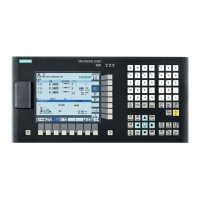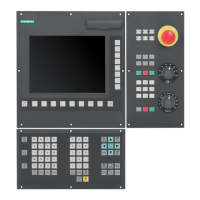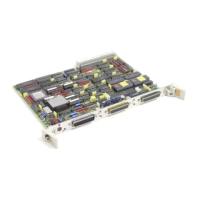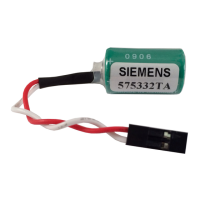Programming and Operating Manual (Milling)
82 6FC5398-4DP10-0BA6, 09/2017
Dimensions in metric units and inches: G71, G70, G710, G700
Fu n ctionality
If workpiece dimensions that deviate from the base system settings of the control system are present (inch or mm), the
dimensions can be entered directly in the program. The required conversion into the base system is performed by the control
system.
; Inch dimensions, also for feedrate F
; Metric dimensions, also for feedrate F
; metric dimensioning from this point on
Depending on the
you have selected, the control system interprets all geometric values as either metric
inch dimensions. Tool offsets and settable work offsets including their display are also to be understood as geometrical
values; this also applies to the feedrate F in mm/min or inch/min. The default setting can be set via machine data.
All examples listed in this manual are based on a
.
G70 or G71 evaluates all geometric parameters that directly refer to the
, either as inches or metric units, for
example:
● Positional data X, Y, Z, ... for G0,G1,G2,G3,G33, CIP, CT
● Interpolation parameters I, J, K (also thread pitch)
● Circle radius CR
●
work offset (TRANS, ATRANS)
● Polar radius RP
All remaining geometric parameters that are not direct workpiece parameters, such as feedrates, tool offsets, and
work offsets, are not affected by
.
however, also affects the feedrate F (inch/min, inch/rev. or mm/min, mm/rev.).
Polar coordinates, pole definition: G110, G111, G112
Fu n ctionality
In addition to the common specification in Cartesian coordinates (X, Y, Z), the points of a workpiece can be specified using
the polar coordinates.
Polar coordinates are also helpful if a workpiece or a part of it is dimensioned from a central point (pole) with specification of
the radius and the angle.
The polar coordinates refer to the plane activated with G17 to G19. In addition, the third axis standing vertically on this plane
can be specified. When doing so, spatial specifications can be programmed as cylinder coordinates.
The polar radius specifies the distance of the point to the pole. It is stored and must only be written in blocks in which it
changes, after changing the pole or when switching the plane.

